Usually when launching a completely redesigned popular model an auto maker tries to make as big a splash as possible. With the fully redesigned 2016 Cruze, Chevrolet has taken the opposite approach. The new car has arrived at dealers very late for a 2016 with no attendant publicity. None are in the press fleets yet. No auto writer that I'm aware of has reviewed one. Is the new Cruze the equivalent of a movie that's so bad that the studio holds no advance screenings for reviewers? Or do they think it's so good that word-of-mouth will do the trick? Or, with a new Camaro, Malibu, and Volt this year (Chevrolet has been extremely busy), did the new Cruze simply fall through the cracks? (The also-redesigned-for-2016 Spark fell through so badly I initially forgot to mention it.) To find out, I did something no self-respecting professional auto writer would do and visited a dealer for a test drive. The bogey: the also all-new-for-2016 Honda Civic.
My experience with the new Chevrolet Cruze was overly brief to discover the subtler aspects of its personality, so consider this a preview with updates to come once I get to spend more time in the car.
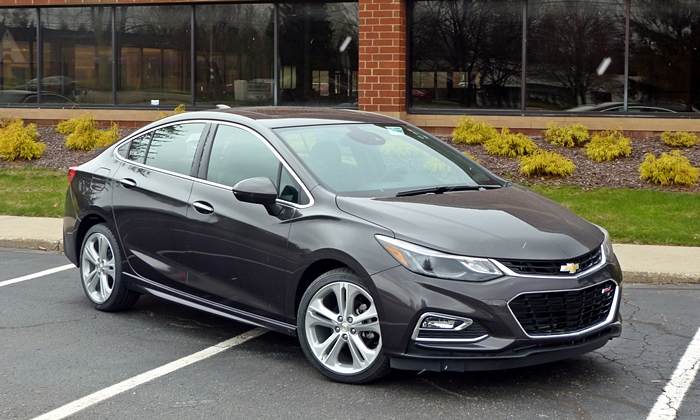
An attractive car, but not a striking or distinctive one. more Cruze photos
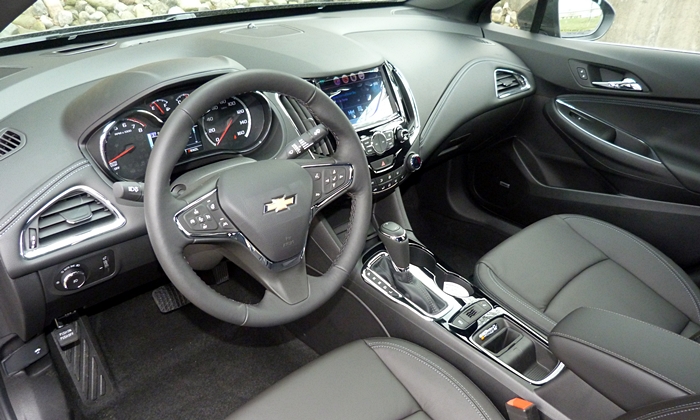
An attractively styled interior. Nothing crazy.
| |
Compared to the Civic |
| Ride smoothness |
 Better
Worse
Better
Worse
|
I experienced no "wow" moments while driving the new Chevrolet Cruze. It's just not that kind of car. Instead, it does just about everything in a quietly competent manner. Like the new Malibu, it's the sort of car Toyota rocked the industry with in the early 1990s, before refinement again took a back seat to cost reduction.
This said, the new Cruze impresses most with the solidity of its structure and the unflappability of its suspension. Though I'd personally like slightly firmer tuning, the Cruze maintained its composure across some pretty bad pavement. The new Civic doesn't ride as smoothly. And the tested Cruze had the lowest profile tires offered, 225/40VR18 Michelin Primacy MXM4s. It should ride even better on the 16s standard on the LT and the 17s standard on the Premier. The Civic was also tested with its lowest profile tires, but these were 215/50HR17 Firestone FT140s, with more sidewall than the tires on the tested Cruze.
| Quietness |
 Better
Worse
Better
Worse
|
I need to drive the new Chevrolet Cruze back-to-back with a competing car on a wider variety of roads to properly evaluate its quietness. But my initial impression was that it's among the quietest compact sedans, and quieter than the Civic, especially on coarse road surfaces and at highway speeds.
Both ride quality and quietness were strengths of the old Chevrolet Cruze. But they should have been, as the old Cruze was along the heaviest compact sedans. GM's greatest achievement with the new car: they maintained a smooth, quiet ride while reducing curb weight by about 250 pounds, a large amount. The new Cruze weighs a little less than the new Civic despite seeming at least as solid, and probably a little more so.
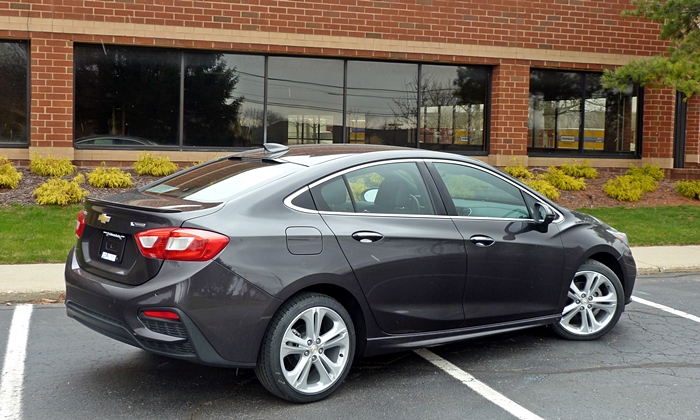
The roof line sweeps in a smooth curve to a short tail.
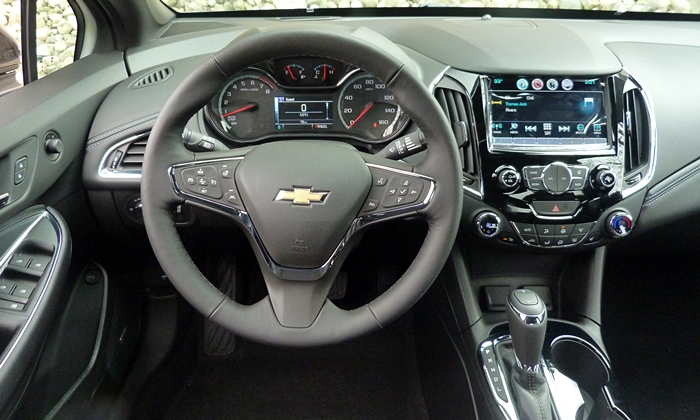
Well-designed controls, including four knobs, except for the range selector on top of the shifter.
| Fuel economy |
 Better
Worse
Better
Worse
|
Weight is the enemy of fuel economy. Partly be reducing the Cruze's curb weight by about 250 pounds, from among the heaviest in the class to among the lightest, Chevrolet improved its EPA ratings from 26 mpg city, 38 mpg highway to 30/42 (30/40 in the tested top-of-the-line trim). The Honda Civic does a little better, 31/42, and the Mazda3 scores nearly as well, 30/41. But all three are close enough to consider them the segment's fuel economy leaders.
The Ford Focus scores as high as 30/42, but only when equipped with a turbocharged three-cylinder engine and a manual transmission.
For 2017 Chevrolet will offer a new 1.6-liter diesel that should deliver outstanding fuel economy. And if you want to avoid fossil fuels entirely, they already offer the related second-generation Volt, which can travel about 50 miles on electricity before a gasoline-powered backup engine kicks on.
| Rear seat room & comfort |
 Better
Worse
Better
Worse
|
The old Chevrolet Cruze, like the Ford Focus, had a rear seat on the tight side even by compact sedan standards. According to the specs, the new one has only gained a few tenths of legroom. But the improvement feels much larger. Chevrolet claims that rear knee room (not a standard spec) has increased by two inches, and this aligns much better with my perceptions.
Some competitors, including the Honda Civic, continue to offer more rear seat space. But the new Cruze's back seat could be the most comfortable in the class for two average-sized men. With a position well above the floor, the rear seat cushion provides much better thigh support than the typical sedan, much less the typical compact sedan. The Civic has a lower rear cushion and insufficient foot space under its front seats, squandering its on-paper legroom advantage.
Up front the Cruze has comfortable seats (though, like those in the Civic, without adjustable lumbar support) but shoulder room typical of a compact car. The Civic has two more inches of shoulder room and feels more like a midsize sedan in the front seat. Both cars have good driving positions with reasonably compact instrument panels.
In L and LS trim, the new Cruze has a 14.9-cubic-foot trunk, nearly identical to that of the new Civic and about as large as you'll find in the class. But the LT and Premier have a compact spare tire that reduces cargo volume to 13.6 cubic feet. Still pretty good.
Next year both cars will also be available as hatchbacks.
| |
Compared to the Civic |
| Price or payments |
 Better
Worse
Better
Worse
|
The attractiveness of the new Chevrolet Cruze's pricing depends on how heavily you option the car.
The Cruze L lists for a very competitive $17,495, nearly $2,000 less than the least expensive new Honda Civic. The problem with the Cruze L for most potential buyers: it's offered only with a manual transmission and no options. Standard features do include automatic headlights, a rearview camera, and ten airbags.
Stepping up to the Cruze LS adds $1,500 to the price but very little to the standard content, eliminating much of the Cruze's initial advantage. Equip both the Cruze LS and Civic LX with automatic transmissions (a CVT in the Honda's case) and the Cruze's advantage falls to just $280 (but with about $650 in additional content). And you still can't get any factory options beyond an automatic transmission with the Cruze LS.
To get a Cruze with more than basic features it's necessary to upgrade to the LT. When both are fitted with automatic transmissions, the $21,995 Cruze LT lists for $2,000 more than the LS, but includes only about $1,150 in additional content plus 16-inch wheels instead of 15s. Add the options necessary to get a sunroof, and it lists for $1,605 more than a Civic EX-T but includes about $600 in additional content, for a feature-adjusted disadvantage around $1,000.
The list price of the top-of-the-line Cruze Premier ranges from $23,995 to $28,640. (The tested car added a couple of accessories to get to $28,825.) A Honda Civic Touring lists for $1,305 less while including about $600 in additional content, for a feature-adjusted difference of nearly $2,000. The Cruze's larger wheels and better tires are worth perhaps $750, but this still leaves the Honda with a large advantage, especially given the brand's stronger reputation and the Civic's much slower depreciation.
To summarize, if you want a car with minimal features, the Cruze L is a great value, but as you move up trim levels and add options the Cruze's price looks worse and worse compared to the Civic's. The L and LS are competitively priced, but the LT and Premier are not. (This "why not" applies only to the upper trim levels.)
Desire something more fun-to-drive than either the Cruze or the Civic? A loaded-up Mazda3 s lists for $575 more than a similarly equipped Cruze Premier. So the Cruze isn't the most expensive car in the class, but driving enthusiasts will gladly pay the additional amount and perhaps as gladly sacrifice some rear seat room and ride comfort for the Mazda's more powerful, yet nearly as fuel efficient, 2.5-liter engine and more engaging handling.
Or maybe the larger Malibu catches your eye. Chevrolet has more aggressively priced its midsize sedan. When both are loaded up, the Malibu lists for $2,735 more than the Cruze before adjusting for feature differences and about $2,000 more afterwards.
| Powertrain performance |
 Better
Worse
Better
Worse
|
If you're looking for a solid, smooth, efficient, and well-equipped compact sedan, there aren't any strong reasons beyond a somewhat high price not to buy the new Chevrolet Cruze. The new car only falls short if you're looking for something sporty, because even with the RS Package (on the tested car) it isn't. The new aluminum-block turbocharged 1.4-liter engine is good for 153 horsepower, 15 more than the old car's iron-block 1.4T, and it has to accelerate about 250 fewer pounds. So the new car is quicker if you dig your spurs into it. But, perhaps owing to its pursuit of those lofty EPA ratings, the engine and six-speed automatic transmission don't feel responsive and don't encourage spirited driving.
The new Honda Civic's engine, though not as stout through the midrange (162 vs. 177 lb-ft of torque) has a stronger top end (174 horsepower) and feels more responsive and energetic. Not that the Civic's powertrain is perfect. Its transmission is a CVT that accepts no driver input beyond a choice among D, S, and L modes. In the Cruze, the driver can at least specify the highest gear into which the transmission can shift using a toggle awkwardly located on top of the shift knob.
I'd much prefer both cars with a manual transmission. One is offered in both cars in lower trim levels. In the 2016 Honda this also requires stepping down to a less powerful non-turbocharged 2.0-liter engine, but for 2017 a manual will be available with the 1.5T engine.
The new Chevrolet Malibu, with a 163-horsepower, slightly larger variant of the same engine and another 200 pounds of curb weight, scores 27/37 in the EPA tests. I must wonder why Chevrolet didn't equip the Cruze Premier with the same 1.5-liter engine to both make it more competitive with the Civic and better justify its price, seeing as they certified the Premier separately anyway. Or, if GM really wanted the Cruze to deliver the performance promised by the RS Package, they could fit the Premier with the 200-horsepower turbocharged 1.6-liter engine recently certified for the new Buick Cascada convertible. Fuel economy would take a severe hit with this engine, though. The half-ton-heavier Cascada is rated 20/27. The much lighter Cruze with the same engine might manage about 25/32.
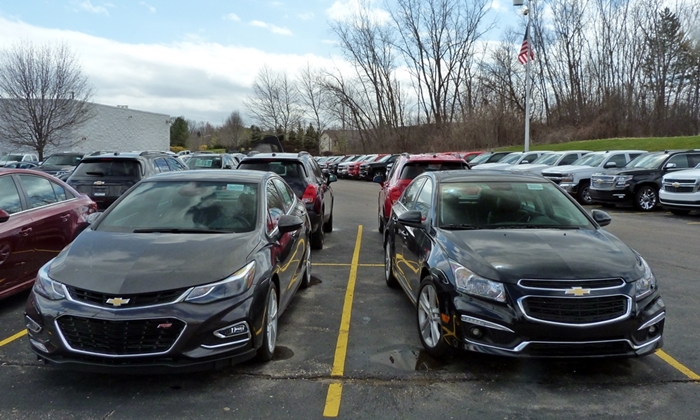
Old face on the right, new face on the left. But the Cruze doesn't drive as sporty as it looks.
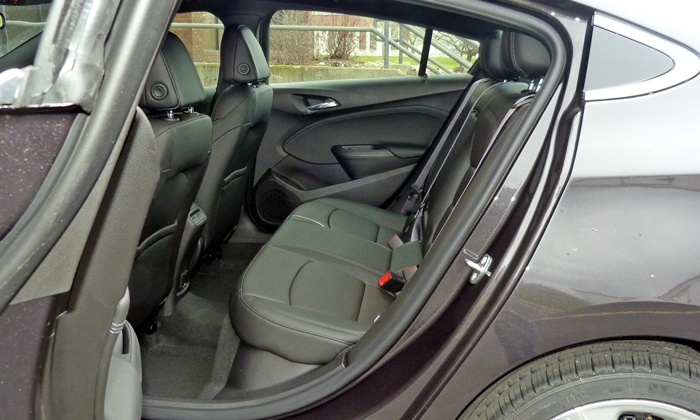
The new Cruze's back seat isn't the roomiest in the class, but it might be the most comfortable.
The situation is much the same with handling. The new Chevrolet Cruze's suspension is tuned very well. In hard turns it understeers (plows towards the outside curb) less than the Honda and feels more composed and precise. Ask, and it will obey. It helps that the Cruze Premier RS's Michelins feel grippier and less mushy than the Civic's Firestones.
But the Cruze isn't an enthusiastic partner on a twisty road. Its steering, though precise, feels less quick, less sharp, and less communicative than the Honda's. As a result, while the Cruze performs better in spirited driving I felt more connected to the Civic and in typical suburban driving enjoyed it more.
Both cars have such good chassis that I'd love to drive more performance-oriented variants. Honda will soon offer the Civic in Si and Type R forms. Chevrolet has announced no similar plans for the new Cruze.
Note: I haven't rated the cars against one another in this area because the Cruze is technically superior but less involving. Any relative rating would depend on which aspect of handling is being compared.
| |
Compared to the Civic |
| Exterior styling |
 Better
Worse
Better
Worse
|
The new Chevrolet Cruze appears considerably sleeker than the staid old one. Its face is more aggressive, its belt line is more raked, and its rear quarters are more fluid. But the whole seems somehow familiar, perhaps too much like some of Hyundai's recent compacts. The new Cruze won't attract many double-takes.
The new Honda Civic, though somewhat similar in shape, appears longer (though it isn't, 182.3 vs. 183.7 inches), lower (it is, 55.7 vs. 57.4 inches), and more dramatic. Some people might find its sheet metal overly busy, even tortured, but overall I prefer it.
Prefer the styling of the old Cruze? Well, Chevrolet continues to offer it as the "Cruze Limited."
| Interior styling |
 Better
Worse
Better
Worse
|
Inside the new Chevrolet Cruze is very tastefully styled, but the new Honda Civic by taking more risks again packs more of a visual wallop. The Honda also has more soft-touch surfaces, though the padded and stitched trim on the face of the Cruze's instrument panel is an unexpectedly posh detail.
| Controls and instruments |
 Better
Worse
Better
Worse
|
The new Honda Civic's interior doesn't fare as well when comparing usability. Its infotainment controls include no knobs. The new Chevrolet Cruze's include both traditional knobs, for tuning as well as volume, and are generally much easier to operate. If the range selector for the transmission weren't awkwardly positioned on top of the shift knob, controls would be among the reasons to buy a new Cruze.
Both cars support Android Auto and Apple CarPlay, through which you can interact with phone-based apps using their controls and displays.
| Feature availability |
 Better
Worse
Better
Worse
|
The new Cruze is offered with many premium features, including automatic climate control, a power driver seat, heated front and rear seats, leather upholstery, sunroof, forward collision warning, lane departure warning and prevention, and blind spot warning. The thing is, the new Honda Civic is offered with nearly all of these features (substituting a passenger side rearview camera for blind spot warning) plus adaptive cruise control, automatic braking, LED headlights. dual-zone climate control (but still no vents for the rear seat), and a four-way power front passenger seat. The Cruze does offer some features the Civic does not: OnStar, auto-dimming headlights, a heated steering wheel, rear obstacle detection, an AC power outlet, and four additional airbags. Overall the Civic has a slight advantage in available features, at least for people turned on by the latest tech.
Like its big brother, the new Chevrolet Malibu, the 2016 Cruze isn't exciting to look at or exciting to drive. But it is attractive, well-appointed, well-equipped (with options), quick when it has to be, fuel-efficient, and thoroughly refined. For people seeking highly competent, comfortable transportation for four adults, it's an excellent compact sedan.
The main things giving me pause are the lack of excitement (for people like myself who seek it in a car) and a high price when well-equipped relative to the also excellent new Honda Civic.
It is possible that with more time in the driver seat I would find the new Cruze more enjoyable to drive. It doesn't have a strong personality, but I'm not quite ready to say it has no personality. Perhaps it just has a subtle one. Hopefully in the not too distant future I'll be able to spend more time getting to know it.
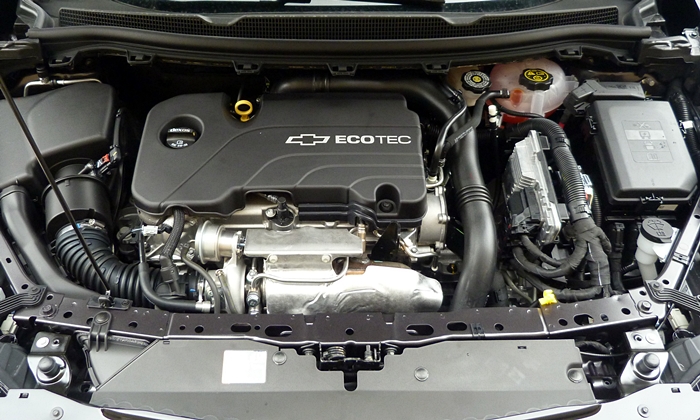
The turbocharged 1.4-liter engine is efficient and sufficiently powerful, but not responsive.
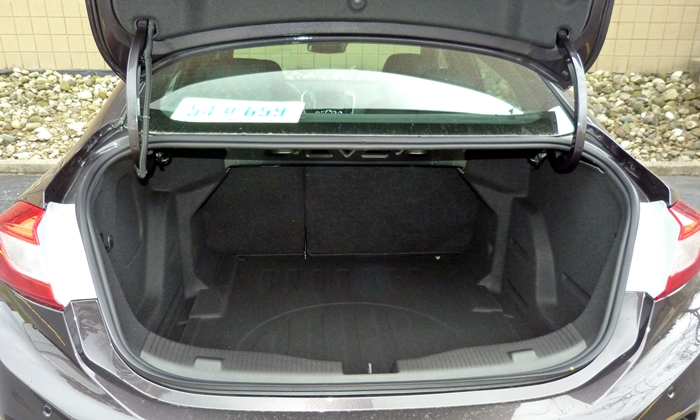
Competitive trunk space.
See more 2016 Chevrolet Cruze photos
Paul Gardulski of Marty Feldman Chevrolet in Novi, MI (248-912-9110) provided a Cruze for a test drive. Michael Smith of Troy Honda (248-884-0959) did the same with a Honda Civic. Both are wonderful to work with.











